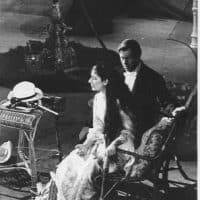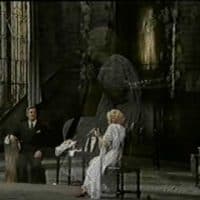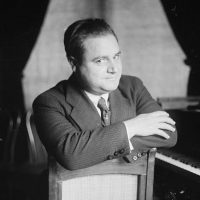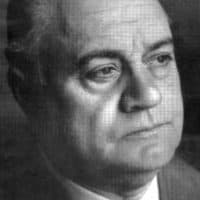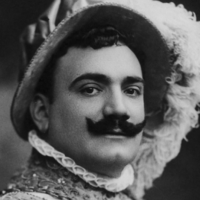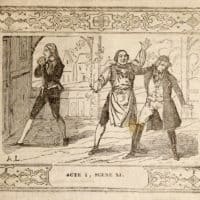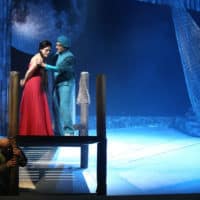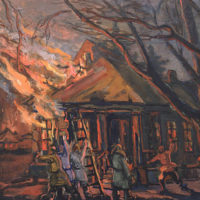 The short, but brilliant career of the Spanish tenor Miguel Fleta lasted for sixteen years, from his debut in Trieste 1919 until his retirement in 1935. He died three years later at the age of 41 only. With his death, his name escalated to the world of legends and those who cherished him spoke of the greatest tenor ever.
The short, but brilliant career of the Spanish tenor Miguel Fleta lasted for sixteen years, from his debut in Trieste 1919 until his retirement in 1935. He died three years later at the age of 41 only. With his death, his name escalated to the world of legends and those who cherished him spoke of the greatest tenor ever.
Miguel Burró Fleta was born in Albalate de Cinca, Huesca, on the 1st of December 1897.¹ At the age of 11 he began the study of solfeggio while working in the local agriculture industry, then later on with his sisters in the Zaragoza district. It was in Zaragoza in 1917, at the age of 20, he first appeared on stage, participating in the Jota-festival of Villanueva de Gállego, decisive for his entry into a singing competition in the city of Zaragoza the same year. He was not premiered but received certain recognition from the jury who admitted his voice qualities were superior to the other contestants.
Late 1917 he moved to Barcelona, where he stayed with his brother who managed to gain an audition with the Director of the Music Conservatory of the Liceu (Isabel II), but his application was declined as there were no vacancies in the male classes. However, Fleta had been overheard by the reputed vocal pedagogue Luisa Pierrick, who taught at the conservatory and with a substantial career as a singer behind her. Pierrick considered the potential of Miguel Fleta to be of such an extent that she admitted him into her own classes, which were confined to female voices.²
Pierrick had good faith in the young Fleta and set out to improve his cultural level, while having him undergo intensive studies of both Italian and French, apart from the studying of solfeggio and vocal training. During the course of 1919 he completed his studies at the Conservatory and started preparing for a professional stage debut. He rehearsed a handful of operatic roles with Pierrick before moving to Milano with her in September upon her insistence (they had fallen in love, and Pierrick had subsequently left her husband for Fleta). By October they had achieved a contract with the opera house of Trieste, after having been introduced to the composer Riccardo Zandonai who was preparing a series of performances of his opera Francesca da Rimini. Fleta made thus his professional operatic debut on the 14th of December at the Teatro Comunale in Trieste in Zandonai’s Francesca da Rimini. He was 22.
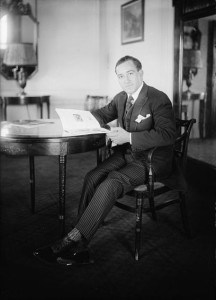 Critics were slightly cool after his debut, but his appearance in Aida in Trieste in January 1920 (in all 13 sessions) completely won the critics over and engagements followed in quick succession. In April he found himself in Wien for Mefistofele, Tosca, Pagliacci and Carmen, and continued to Budapest, Praha and Warzawa, before returning to Wien in October where he met Puccini and starred in the local premiere of the composer’s La Rondine. He opened 1921 with two performances of Aida in Monte Carlo and then returned to Italy where he sang in Livorno, Palermo, Napoli, Roma and Bologna, all sessions highly successful. At the Fenice of Venecia he created sensation with his Rigoletto and Carmen, and it has been reported that he was applauded during 20 minutes after his appearance, bringing him onto the stage 16 times after curtain fall.³
Critics were slightly cool after his debut, but his appearance in Aida in Trieste in January 1920 (in all 13 sessions) completely won the critics over and engagements followed in quick succession. In April he found himself in Wien for Mefistofele, Tosca, Pagliacci and Carmen, and continued to Budapest, Praha and Warzawa, before returning to Wien in October where he met Puccini and starred in the local premiere of the composer’s La Rondine. He opened 1921 with two performances of Aida in Monte Carlo and then returned to Italy where he sang in Livorno, Palermo, Napoli, Roma and Bologna, all sessions highly successful. At the Fenice of Venecia he created sensation with his Rigoletto and Carmen, and it has been reported that he was applauded during 20 minutes after his appearance, bringing him onto the stage 16 times after curtain fall.³
In January 1922 he reappeared in Zandonai’s Francisca da Rimini at the Teatro Costanzi in Roma and Zandonai chose him to to create the role of Romeo for his new opera Giulietta e Romeo, where the conductor himself conducted the premiere at the Costanzi 14 February 1922.
Fleta was now, shortly after his debut, a fairly reputed and loved tenor and he was invited to Milano for a recording session for Gramophone in April the same year.4 He parted for his native country, Spain, a month prior to the Milano sessions for his debut at the Teatro Real in Madrid. His success as Don José in Carmen was clamorous and triggered a rise of nationalism, españolismo, which was to extend throughout all the Hispanic countries in South- and Latin America. Further appearances in Madrid included Tosca, La Boheme and Aida. Fleta returned to Italy for appearances in Genova in Milano before departing for South America. He had been invited to sing at the Teatro Colón of Buenos Aires and debuted on the 24th of July in Cavalleria Rusticana, followed by the world premiere of Flor de Nieve by the local composer Constantino Gaito on 3 August 1922, as well as the local premiere of Zandonai’s Giulietta e Romeo. Further appearances followed in Córdoba, Rosario, Montevideo (Uruguay), and Sao Paolo (Brazil). In Rio de Janeiro he appeared in Il Guarany by the local composer Carlos Gomes.
The South American successes continued. In Mexico he sang Bréton’s La Dolores staged inside the bullring El Coso de la Condesa to thousands of spectators, for which he received the incredible amount of 50.000 pesos gold. South America was living the segregation between the “Fletistas,” the supporters of Fleta, as opposed to the “Lazaristas,” the supporters of Lázaro, and Fleta, now almost deified by the South American audience, was heavily threatening Lázaro’s position as the most popular tenor on the pacific continent. Fleta did further successful appearances throughout Cuba January 1923, before returning to Madrid and London, where he once more recorded for Gramophone in March. June had him returning to Argentina and the Colón of Buenos Aires where he was hired for Manon, I Compagnacci by Riccitelli and la Sonnambula in July. He kept appearing in Argentina, Uruguay and Brazil throughout August and September, but was called to New York for the month of October.

Miguel Fleta was 26 and about to debut at one of the most prestigious opera houses in the world, the Met in New York. Gigli, Martinelli and Lauri-Volpi had all left Italy and La Scala for the Met, where they enjoyed divo status and ditto salaries. Fleta debuted on the 8th of November with Tosca, followed by Mascagni’s L’Amico Fritz on the 15th. During the season of 1923-24 he performed at the Met in Rigoletto, Pagliacci, Tosca, La Bohème and Andrea Chénier, with occasional performances in Philadelphia.
Then finally in 1924 he debuted at La Scala after a controversial rehearsal of Rigoletto, where he had argued with Toscanini himself concerning the cadenza to La donna e mobile. Apart from Rigoletto, Fleta also performed in Carmen and Tosca before returning to Madrid in March for his third season with the Teatro Real. In Madrid he also received the Order of Alfonso XII, granted by King Alfonso XIII.
Late July that year he parted on his third trip to the American continent and added Alfredo of La Traviata to his repertory in August at the Teatro Colon. The reception in Argentina was ecstatic; Rio de Janeiro trembled and Santiago de Chile fell to its knees and Fleta’s popularity rose to the dimensions of giving his name to shirts, shoes, hats – whatever. From South America he headed towards La Habana, Cuba, and finally New York, where he participated in a gala in honour of Puccini, performed in La Bohème and added Les Contes d’Hoffmann to his repertory. He was never to appear at the Met again.
Fleta was in fact scheduled to perform at the Met for further two more seasons (1925-27), but influenced by his Spanish agent he signed with the Teatro Apolo in Madrid and told the Met management that he was due for Military Service in Spain. The management at the Met disclosed the lie upon examining the excuse with the Spanish Government and initiated a lawsuit against Fleta that was to last for three years and resulting in a considerable fine for Fleta.
Meanwhile, Fleta initiated an exhausting year (1925) starting with a series of performances in Madrid before embarking on a tour throughout Spain with great success in Barcelona, Valencia, Sevilla, Granada, San Sebastian, Bilbao, Zaragoza, Huesca and Burgos, plus a short visit to Portugal for appearances in Lisboa and Oporto. In some weeks he performed daily in La Boheme, Aida, Tosca and Carmen, despite the obvious risk of damaging his instrument and a slowly emergent fatigue. Fleta was at his peak, the audiences loved him and he turned into the pride of the Nation.5
Perhaps his greatest success and recognition came with the world premiere of Puccini’s Turandot at La Scala, presented posthumously and left unfinished by the composer, on 25 April 1926. The conductor was Toscanini and he had chosen Fleta to create the role of Calaf, Fleta thus snatching the role from Aureliano Pertile, Toscanini’s alleged favourite tenor at La Scala, and Beniamino Gigli, who supposedly had been the tenor for which Puccini had created the role.6
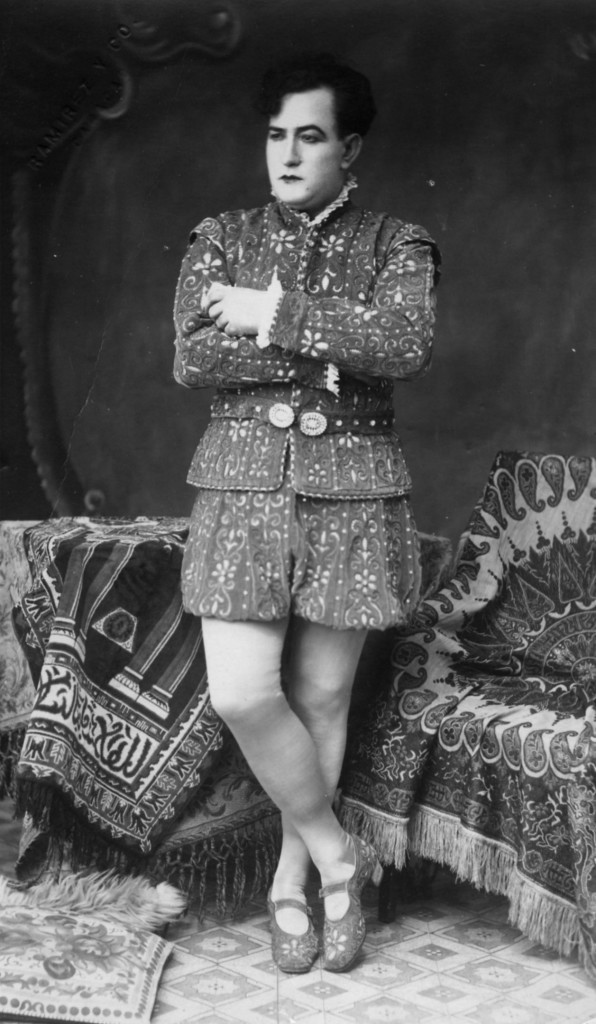 Curiously enough, he had yet not appeared at the Liceu in Barcelona, and expectations were high as the Liceu proclaimed that Fleta would sing in Carmen during the month of October (1926). He debuted on November 5th 1926, it was the first time ever in Spain an opera performance was transmitted live by radio, and all other theaters of the city of Barcelona interrupted their sessions in order to connect with the Liceu for Fleta’s Aria di Fiore. The success was clamorous and repeated itself at Fleta’s debut in Wagner’s Lohengrin at the Liceu on December 14 1926. At the moment of the famous Racconto in the third act, the audience burst into a clamorous frenzy and begged the aria to be encored, somewhat unusual in the history of that opera.
Curiously enough, he had yet not appeared at the Liceu in Barcelona, and expectations were high as the Liceu proclaimed that Fleta would sing in Carmen during the month of October (1926). He debuted on November 5th 1926, it was the first time ever in Spain an opera performance was transmitted live by radio, and all other theaters of the city of Barcelona interrupted their sessions in order to connect with the Liceu for Fleta’s Aria di Fiore. The success was clamorous and repeated itself at Fleta’s debut in Wagner’s Lohengrin at the Liceu on December 14 1926. At the moment of the famous Racconto in the third act, the audience burst into a clamorous frenzy and begged the aria to be encored, somewhat unusual in the history of that opera.
In May 1927 he remarries after a short separation from Luisa Pierrick, and travels to Argentina with his new wife, Carmen Mirat, where he combines his honeymoon with the fourth tour of America, with appearances in Buenos Aires, Montevideo, Rio and New York. He tends to cater for the Zarzuela repertory more and more.
Fleta inaugurated 1928 with an European tour. Although being tired and with slight vocal problems, he undertook to appear in Wien, Budapest, Praha, Roma and Paris, ending with a severe faringiitis and general fatigue. The lawsuit with the Met came to an end and Fleta rejected further engagements due to his condition, and by the end of the year he was forced to undergo vocal therapy in order to recuperate. Despite his ill-fated program in the preceding years, he could not resist a lucrative offer from Casa Daniel in Madrid to tour the Far East and the American continent, and eventually set out on an extremely taxing experience in 1929 which covered Japan, China, Mexico, Guatemala, Cuba, Puerto Rico and Canada, followed by a tour of Central Europe by the beginning of 1930.
Overworked and tired, the remainder of 1930 only brought sporadic appearances. A growing political engagement had him appearing in events of political propaganda for the Republic of Spain, who’s official policy allegedly had promised a wide cultural support for music and music education in Spain, securing Fleta’s open affiliation with and support for the government.
In 1932 he yet again undertook a tour which this time included the Scandinavian countries, Greece and Italy, plus separate appearances in Portugal in Tosca and Rigoletto. Casa Daniel then had him touring Spain.
It seems Fleta’s career evolved in parallel with that of his grand rival, Hipolito Lazaro. Like Lazaro, he appeared more and more in Zarzuela roles and during 1933 he embarked on a national tour singing Zarzuelas with particular success in Doña Franciscita. Word had it that Fleta still suffered from vocal problems, explaining why, like Lazaro, he engaged in Zarzuela and neglected the operatic repertory. Some sporadic opera roles followed in 1934, with performances of Carmen in Cannes and Nice, and further apperances in Amberes, Bruxelles, Munchen and Cairo, before he yet again toured Spain with the Zarzuela repertory in 1935, this time with Maestro Moreno Torroba and his company. His repertory consisted of Marina, La Dolorosa, Doña Franciscita and Luis Fernanda. Every now and then he also performed in Carmen, which had become his operatic hallmark in Spain.
In 1936 he participated in the premiere of the opera Christus by the local composer Alvarez Garcia at the Calderon in Madrid and was appointed professor of singing at the conservatory in Madrid just before the outburst of the Spanish Civil War. Having been let down by the Rebulicans in their failing and negligent support for the music education in Spain, Fleta had abandoned his political support for the Republic and joined the fascist oriented Falange, which forced the Fletas to flee from their home in Albalate to Salamanca and La Coruña with the onset of the war. Fleta himself enrolled as a chofer at the air base in Salamanca while giving occasional recitals for the Social Aid in several Spanish cities from 1936 to 1938. He gave his last complete opera performance in Portugal, at the Coliseo dos Recreios in Lisboa on 27 April 1937, where he sang Carmen.
In May the following year he fell ill with what seemed to be an acute renal infection, but he died of Uremia on the 29th of May 1938 in his home in La Coruña. The burial took place the day after in La Coruña. With his death, his name escalated to the world of legends and those who cherished him spoke of the greatest tenor ever.
1 – According to some sources Fleta’s birth date is 28 December 1897.
2 – It is said that Fleta sang for the reputed maestro Juan Lamote de Grignon, and his voice travelled in the hallways of the Conservatory and reached Perrick’s classroom, and preplexed by the splendour of the voice the female students rushed out into the hallways to see who its master was. When learning of his rejection, Perrick shall have uttered the words: “In my class there’s a vacancy, if it is of no inconvenience to accept a tenor.”
3 – Fleta appeared at the Fenice di Venezia on the 27th of October 1921. An Italian reporter asked him after the session how it was possible to sing with such devotion, to which Fleta responded: “Because tonight I was not Miguel Fleta, I was Don José.” Thus Fleta had created somewhat of a legend, and his Don José was to be remembered as one of the foremost interpretations ever. (Ref.: Teatro Barkaldo).
4 – Fleta recorded the final scene from Zandonai’s Giulietta e Romeo and Don José’s Flower Aria from Carmen. Shortly after he recorded Ay, Ay, Ay by the Chilean composer Osman Pérez Freire, which achieved phenomenal sales, played in virtually every household where a gramophone was present.
5 – The King himself, Alfonso XIII, was the padrino (God Father) to Fleta’s newly born son, Alfonso, in January 1926, where also the prime minister, Primo de Rivera, was present.
6 – Whether Fleta really was the desired tenor for the part of Calaf at the World Premiere of Turandot is somewhat controversial as it is known that neither Toscanini nor Puccini did think too highly of the Spanish tenor, and Toscanini himself would probably much rather have seen his preferred and loved Aureliano Pertile in the role. However, it might have been an act of vengeance, as Ph.D. Joseph Fragala points out: “Firstly, he wished to inflict a bad turn towards Puccini with whom there existed a reciprocal love-hate relationship when the latter was still alive. Secondly, Fleta (already in decline) was notoriously hated by Puccini and Toscanini concocted a spiteful act against the great composer’s memory by choosing Fleta. Thirdly, Toscanini, in a case of pure revenge, deliberately put aside Lauri-Volpi with whom he had not yet made peace after a shocking incident of Rigoletto at La Scala in 1922. It was Lauri-Volpi and not Beniamino Gigli, whom Puccini, a great expert on vocal values and admirer of Lauri-Volpi, intended for the role of Calaf.”
